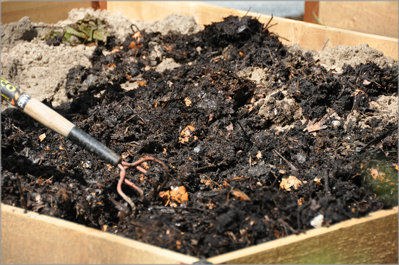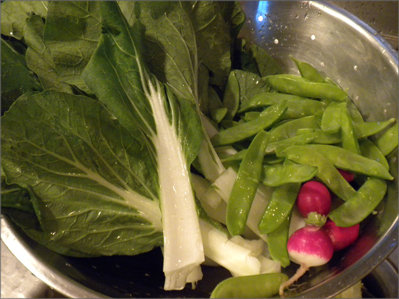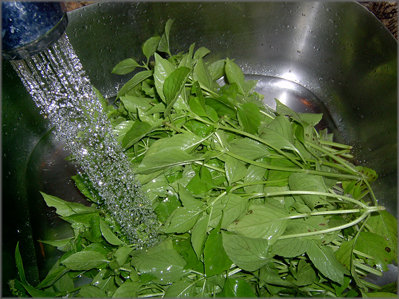





Not all microbes are bad
As a gardener, I love digging in the dirt. And you probably do too. First, let's clear the air about microorganisms...they are all not bad. Good microbes are everywhere, including garden soil and compost. Soil contains nitrogen-fixing bacteria, nitrifying bacteria, denitrifying bacteria and actinomycetes. For more information about these beneficial compounds, visit the U.S. Department of Agriculture's Natural Resources Conservation Service website about Soil biology, and check out the Dave's Garden article written by Darius Van d'Rhys, 'The Importance of Microbes in Soil'.
Most microorganisms are good, playing vital roles in our  ecosystem. It is the dangerous bacteria and viruses that contaminate foods and cause sickness, and even death, that we need to be mindful of. According to the Centers for Disease, Control and Prevention (CDC), there are an estimated 76-million cases of foodborne illnesses resulting in 5,000 deaths in the United States each year.[1]
ecosystem. It is the dangerous bacteria and viruses that contaminate foods and cause sickness, and even death, that we need to be mindful of. According to the Centers for Disease, Control and Prevention (CDC), there are an estimated 76-million cases of foodborne illnesses resulting in 5,000 deaths in the United States each year.[1]
Proper cooking of raw foods (especially animal foods) like meat, poultry, or eggs - kills off foodborne pathogens, such as Salmonella bacteria. However, seemingly safe foods that we grow in our gardens, including fruits, vegetables and herbs, can also harbor dangerous bacteria. We have the option to eat these foods uncooked, and uncooked foods contaminated with salmonella or norovirus can cause sickness.
Norovirus and Salmonella infections are the most reported causes of food borne illness in the U.S. They are especially dangerous for the elderly, infants and young children, pregnant women and their unborn babies, and people with weaker immune systems (such as individuals with cancer or HIV/AIDES), all of whom have a higher risk for foodborne illness.
What is Norovirus? 
Norovirus is among a group of related viruses that cause acute gastroenteritis in people. The most common symptoms include nausea, diarrhea, vomiting, stomach ache and pain. These symptoms usually occur within 24-48 hours after eating the contaminated food. Noroviruses are commonly spread by eating or drinking fecal contaminated food or water. The majority of reports come from restaurants, nursing homes, schools, and cruise ships, more so than at home residences. The symptoms usually last for 1 to 3 days.
What is Salmonella?
Salmonella bacteria live in the intestinal tracts of infected animals and humans and pass in their feces. Symptoms of salmonella contamination include diarrhea, abdominal cramps, and fever - usually within 8 to 72 hours after eating the contaminated food. Other symptoms may be headache, nausea, vomiting and chills. These symptoms usually disappear within 4 to 7 days.
Protect Yourself and Your Family
You can see why it becomes so very important to thoroughly rinse and wash off garden fruits and vegetables before eating them. Safe food handling practices become critical in sickness prevention. Produce rinses are readily available in the stores, but how many of us actually use them? Okay, I know many people do, and that is a good thing, but did you know that plain water rinsing with friction seems  to work too? A study by the Connecticut agricultural experimental station found there was little or no difference between tap water rinsing or using a fruit and vegetable wash in reducing residues of nine pesticides that they studied.[2]
to work too? A study by the Connecticut agricultural experimental station found there was little or no difference between tap water rinsing or using a fruit and vegetable wash in reducing residues of nine pesticides that they studied.[2]
Another study by the Department of Microbiology and Cell Science, Institute for Food and Agricultural Sciences, at the University of Florida found that a 10% vinegar to water solution was significant in removing 90-95% bacteria and viruses from strawberries.[3]
More Food Safety Tips
• Wash your hands often!
• Sanitize your counter tops and kitchen sinks - you can disinfect using a chlorine bleach solution with a concentration of 1000-5000 ppm, which is 5-25 tablespoons of household bleach [5.25%] per gallon of water, according to the CDC.
• Cook foods to safe internal temperatures
• Don't cross contaminate - use separate cutting boards for meat and produce
Fruits and Vegetables = part of Your Healthy Diet
Don't let all this talk ruin your appetite for nutritious fruits and vegetables; any food can become contaminated. Follow the above food safety tips and rinse all produce well before eating to enjoy safer foods.
References
[1] CDC Surveillance for Foodborne Disease Outbreak
[2] Removal of Trace Pesticide Residues from Produce
[3] Lukasik J, Bradley ML, Scott TM, et.al.; J.Food Prot. Reduction of poliovirus 1, bacteriophages, Salmonella montevideo, and Escherichia coli O157:H7 on strawberries by physical and disinfectant washes. 2003 Feb;66(2):188-93.
Related DG Articles: Soil (Don't call it Dirt) By Paul Rodman
Related Links:
NY Times Soap and Water Rinse Gets Produce Cleanest By Anahad O'Connor
FDA Produce Safety - Safe Handling
Home Food Safety
Fruits and Vegetables Benefits
6 Steps to Safer Fruits and Vegetables
Copyright © www.100flowers.win Botanic Garden All Rights Reserved